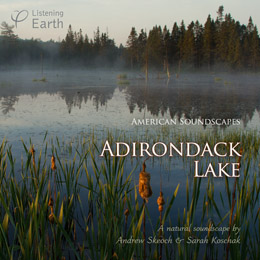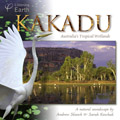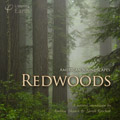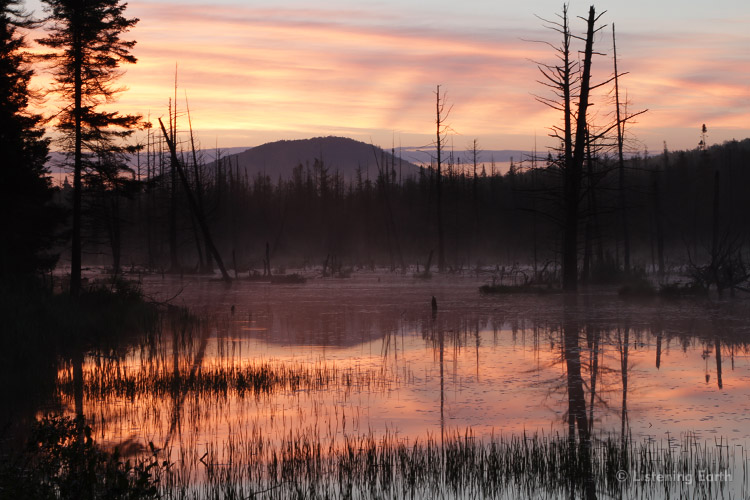

Running Time:
189 min
Release Date:
December 2018
Recording Location:
Beaver Lake, Adirondack Mountains, New York State
If you like this album,
we also recommend:
Adirondack Lake
The still waters of a small lake in the Adirondack mountains of northeastern United States reflect the first glimmers of the approaching dawn. The treeline and low hills beyond stand out against a paling sky.
Bullfrogs and Peepers have been calling almost continually throughout the night. Now this amphibian chorus subsides as the light grows. As we listen from the lake edge, the air begins to shimmer with the delicate sounds of passerine birdsong. It emanates from nearby forest and drifts across from the far shores - Swamp Sparrows, Pine Warblers, Olive-sided Flycatcher and Ruby-crowned Kinglets. An Common Grackle give querulous calls, and an American Robin is heard in sequences of sublime song. A coyote calls distantly, and later, the barks of a deer echo across the lake.
On this recording you can hear the scale of the landscape, as frog calls define the lake edge and birdsong echoes off the treeline. This album takes us into a still morning of listening, as sunlight slants through drifts of steam rising from the waters.
Andrew comments:
"I made this recording in the company of two of my closest colleagues in America; Lang Elliot and Doug Quin. Both are sensitive nature recordists and naturalists, and as each is based in upstate New York, the Adirondacks are their backyard.
"Doug has had a varied recording career, including making what I consider the single, most astonishing nature recording I've yet heard; Weddel Seals vocalising under the Antarctic sea ice.
"Lang is a deep-hearted man, with a wonder-filled curiosity and connection with the natural world. He achieves such beauty with a pair of microphones. He also delights in playing the clown, so our time in the field was filled with amusement at his goofery. I recommend Lang's 'Music of Nature' blog and soundcloud channel. (When you click on his blog, you'll see a link to his podcast series, with a photo of him peeking out from behind his beloved SASS microphone. Sarah took that pic of him mucking about during our time in the Adirondacks.)
"We spent several days out in the field, frustrated by rain and stormy weather. On our final morning, the sky cleared and winds stilled, allowing this recording."
Audio sample of this album
|
1. |
Part 1: 4.30am - Bullfrogs, Peepers and the dawn chorus |
61.20 |
|
2. |
Part 2: 5.30am - Sunrise, after the dawn chorus |
67.26 |
|
3. |
Part 3: 6.40am - Morning birdsong |
60.29 |
Purchase this
album as:
Digital Album
(for immediate download)
Download this album
for as little as
$7.50 -
View Special Deals
(Prices AU$, exGST)
Mp3:
Mp3 is a universal audio format, playable on iPods, computers, media players and mobile phones.
Mp3 is a compressed format, allowing smaller filesizes, offering faster download times and requiring less storage space on players, but at some expense to the audio quality. Many listeners can't really hear the difference between mp3 and full CD-quality audio, and hence its convenience has lead to it becoming the default option for audio.
Our albums are generally encoded at around 256kbps (sometimes with VBR), balancing optimal audio quality without blowing out filesizes excessively. We encode using the Fraunhoffer algorithm, which preserves more detail in the human audible range than the lame encoder.
Our mp3 files are free of any DRM (digital rights management), so you can transfer them to any of your media technology. You've paid for them, they're yours for your personal use without restriction.
Mp3 files can be burned to disc, either as an mp3 disc, or an audio CD after converting them to a standard audio (.wav or .aif) format first.
FLAC:
FLAC is a high-quality audio format, allowing CD-resolution audio. It is ideal if you wish to burn your files to a CDR, or listen over a high resolution audio system. However files usually require special decoding by the user before playing or burning to disc.
FLAC (Free Lossless Audio Codec) is a LOSSLESS compressed audio format. This means that it preserves the full audio quality of a CD, but optimises the filesize for downloading. Typically, file sizes of around 60% are achieved without any degradation or loss of audio quality from the source files at the CD standard of 16bit/44.1kHz.
Obviously the file sizes are larger than for the mp3 version - usually around 300-400Mb for an album, compared to 100Mb for an mp3 album.
In addition, you'll need to know what to do with the files once you've downloaded them. In most cases you'll want to decode the files to wav or aiff, either to import into programs like iTunes, or burn to CDR. Some programs will play flac files natively.
There is a lot of information about flac online (eg: http://flac.sourceforge.net/)





 Alternate audio link
Alternate audio link 